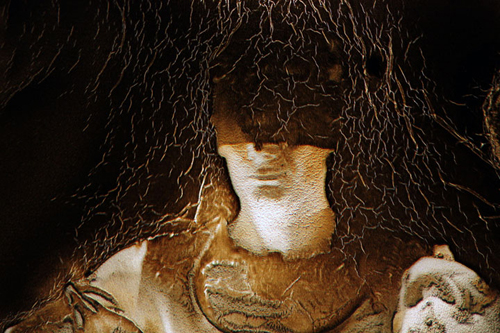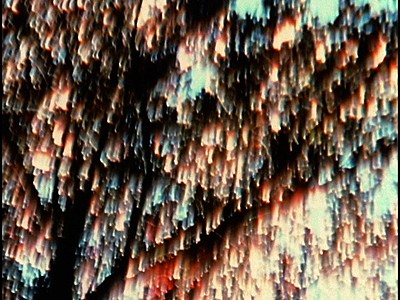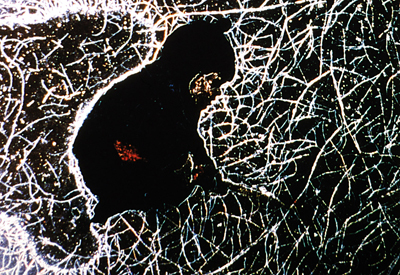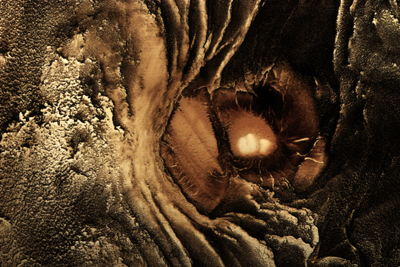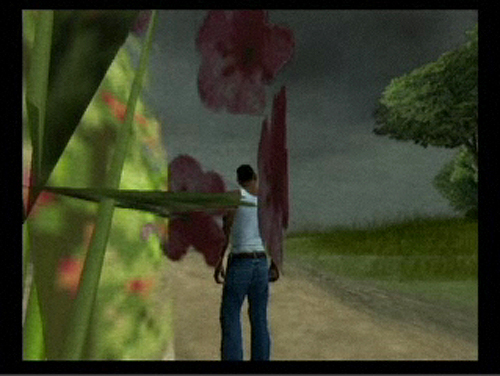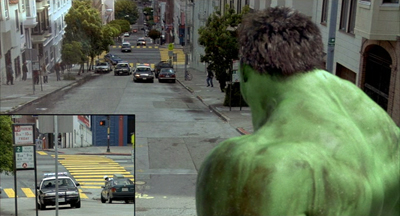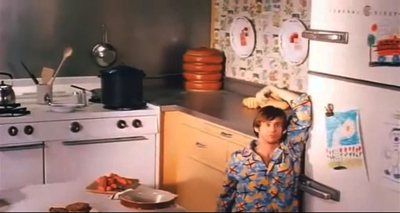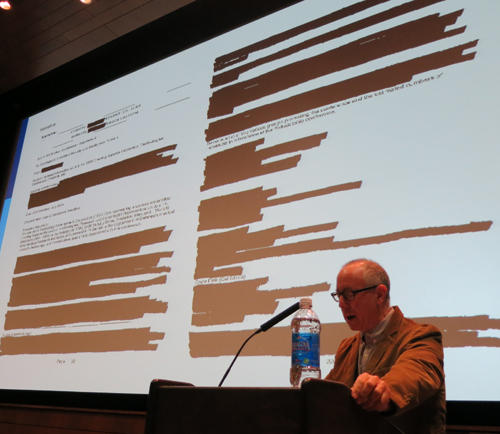Archive for May 2012
Solomonic judgments
The Great Blondin, from American Falls.
DB here:
Before you read any further, please go here and look and listen. Click on a few of the sample clips, such as Still Raining, Still Dreaming and Rehearsals for Retirement. Now try the extracts from American Falls here.
Take your time; I’ll wait.
Back? Good.
These excerpts can give you the flavor of Phil Solomon’s extraordinary filmmaking better than any prose of mine could. Solomon has been a major figure in the American avant-garde for nearly thirty years. I’m no expert on his work, but his visit to Madison during our film festival last month gave me a chance to see some of it the way it should be seen: On a big screen, with superb projection and sound thanks to our new Kinotons. (Phil said his films had never looked or sounded better.)
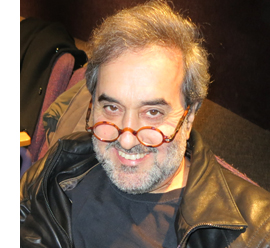 Phil Solomon came of age in the late 1970s, after American experimentalists had already created several imposing masterpieces. Bruce Conner, Stan Brakhage, Hollis Frampton, Ken Jacobs (with whom Solomon studied in Binghamton), and many other filmmakers had in the 1960s and early 1970s given the world what Solomon calls Big Films. Collage-based (Conner’s A Movie and Report), lyrical (Brakhage’s Twenty-Third Psalm Branch), Structural (Frampton’s Zorns Lemma, Jacobs’ Tom, Tom the Piper’s Son), or narrative (Jim Benning’s 11 x 14), these monumental works were intimidating in their length, ambition, and formal and thematic sweep. What were young filmmakers to do?
Phil Solomon came of age in the late 1970s, after American experimentalists had already created several imposing masterpieces. Bruce Conner, Stan Brakhage, Hollis Frampton, Ken Jacobs (with whom Solomon studied in Binghamton), and many other filmmakers had in the 1960s and early 1970s given the world what Solomon calls Big Films. Collage-based (Conner’s A Movie and Report), lyrical (Brakhage’s Twenty-Third Psalm Branch), Structural (Frampton’s Zorns Lemma, Jacobs’ Tom, Tom the Piper’s Son), or narrative (Jim Benning’s 11 x 14), these monumental works were intimidating in their length, ambition, and formal and thematic sweep. What were young filmmakers to do?
Some of the juniors, Tom Gunning pointed out in an influential essay at the time, backed off from these epic visions. Aiming at a more intimate cinema, they used their forebears’ discoveries in modest, fairly impersonal ways–somewhat as Wallace Stevens’ chiseled compactness reworked the techniques that Eliot splashed on a bigger canvas in The Waste Land. Solomon agrees that he joined this deliberately “minor” filmmaking tradition, exploring the fine grain of imagery and what Gunning calls “submerged narratives.”
The task these young filmmakers set themselves was to present a recognizable world, and then poeticize it in a more modest way than the 1960s generation had. The tension between pictorial abstraction and realistic representation is central to much cinema, but it’s felt most keenly by experimentalists. Solomon pursued the problem through found footage and rephotography. Uncomfortable shooting original footage, particularly of people, he preferred to scavenge home movies and classic films to rework at his leisure. He filmed from television, old films, even Super-8 viewfinders. His optical printer stopped or stepped shots or blew up bits of the frame. He became identified with one particular technique: the use of chemicals to alter the film after it had been processed.
Solomon’s classics are unabashedly beautiful. The Secret Garden (1988) draws on children’s literature and film to present a dazzling image of paradise. James Cameron’s Avatar gives us glowing branches, but with the bland sheen of a Doré illustration. Who wouldn’t prefer Solomon’s radiant, evocative forest, created through optical printing distorted by lens aberrations?
Like Bruce Conner, Solomon enjoys popular media and its iconography, but unlike Conner’s his concern isn’t satiric or ironic. The Twilight Psalms are drawn from Twilight Zone and Outer Limits episodes, and images of Houdini flit in and out. The purpose is to enhance mystery and, inevitably, a sense of mournful decay.
The risk in such ravishing imagery is that it becomes merely pretty. Solomon doesn’t want to make decorative films, he says, and the pulsing, swarming shapes that gnaw into the figures recall the ravages of decomposing nitrate stock. Solomon says he practices “reverse archaeology”: “I throw dirt back on.” Dirt never looked better.
He’s reluctant to talk much about his methods, worrying that the conversation will turn away from the viewer’s experience. But he explained to us that once he has obtained his images, he “unmoors” them chemically by loosening the emulsion and subjecting it to chemical treatment. The result allows fungal growths and craquelure to overrun areas that harbor the silver bromide grains. Like embossing, the technique adds roundness and shading to the flat images. It reminds you that film has volume and that it can become, at very minute levels, a sculptural art.
Another risk of dazzling us with imagery is that the overall form of the film becomes elusive, merely a support for striking effects. One feature of both Structural Film and New Narrative was an insistence, in P. Adams Sitney’s phrase, on overall shape. Watching films like Zorns Lemma and J. J. Murphy’s Print Generation, the viewer is invited to work out a broad architecture into which each moment fits precisely. Solomon’s films are more diffuse, avoiding patterns that are perceptible on first acquaintance and moving toward more associative and elusive organization. What binds the films are recurring motifs (e.g., the hospital patients glimpsed in the punningly titled Remains to Be Seen) and emotional tone, often a quiet melancholy that builds toward lamentation.
I haven’t seen some of Solomon’s newest work, which reconfigures imagery from video games in the manner of machinima. Again, the samples on his site are very intriguing. But one screening at Madison brought us a very impressive recent item. At the end of the 2000s Solomon seems to have felt ready to tackle his own Big Film.
American Falls developed over several years, partly in reaction against the “one-liner art” Solomon saw as dominating the Whitney Biennial. American Falls began life as a gallery installation but in the 2010 version we showed in Madison, it was a triptych running nearly an hour. If The Secret Garden refers obliquely to children’s literature, here a national myth is boldly thrust forward. No “submerged” narrative here.
Referencing Ives’ “Three Places in New England” as well as Griffith, Keaton, Citizen Kane, Night of the Hunter, the Titanic, All Quiet on the Western Front, Pearl Harbor, the Rosenbergs, the JFK assassination, and the Civil Rights movement, American Falls offers nothing less than a panorama of twentieth-century American history. It starts with Annie Edson Taylor, who in 1901 became the first person to survive going over Niagara Falls.
The shots, bronzed throughout, seem stamped onto the surface of the screen, even as textures wriggle and pulse within the contours. I was reminded of a Rauschenberg combine, in which all manner of source imagery is given a busy but unifying finish. Another analogy is Gavin Bryars’ great musical piece The Sinking of the Titanic, which incorporates shards of spoken testimony into a ceaseless, majestically somber texture. (You can listen to some of it here.) Needless to say, Solomon references the Bryars piece too.
The film is a plangent survey of the failures of a dream: America has fallen. Yet even this “night prayer,” as Solomon calls it, can’t cancel the captivating charms of his pictures and sounds, and he knows it. When he was asked why Hitler didn’t appear in his saga, he replied that he didn’t want to make Hitler beautiful.
The sources for American Falls are listed extensively on Solomon’s site. (Another return to Big Art form, as with Eliot’s Waste Land footnotes?) In any case, on a single screening the film seemed to me to achieve a resonant eloquence. Big or small, a Solomon film merits seeing, hearing, and study. Although the films shine forth best on a big screen, Phil looks forward to making his work available to wider audiences on DVD. So do I. These are films you can live with a long time.
Tom Gunning’s essay mentioned above is “Towards a Minor Cinema: Fonoroff, Herwitz, Ahwesh, Lapore, Klahr and Solomon,” Motion Picture III, 1/2 (Winter 1989-90), 2-5. A detailed interview with Solomon appears in Scott MacDonald, A Critical Cinema 5: Interviews with Independent Filmmakers (University of California Press, 2006), 199-227. Jacob W. at Making Light of It provides a very useful dossier on Solomon’s career, with some critical essays. Two strong essays on Solomon’s videogame-inspired films are Michael Sicinski, “Phil Solomon Visits San Andreas and Escapes, Not Unscathed: Notes on Two Recent Works,” Cinema Scope no. 30 (Spring 2007), 30-33, available here; and John P. Powers, “Darkness on the Edge of Town: Film Meets Digital in Phil Solomon’s In Memoriam (Mark LaPore),” October no. 137 (Summer 2011), 84-106.
Solomon’s vimeo page displays other aspects of his interests.
Special thanks to John Powers for programming these films and bringing Phil to Wisconsin.
P.S. 22 April 2019: Phil Solomon died on 20 April. This is a huge loss to American film. Because some of my links to his work online have failed, I’ve revised the references supplied at the start of this entry.
Crossroad (2005; Phil Solomon/ Mark LaPore).
A man and his Focus
James Schamus on State Street, hailed by local livestock.
DB here:
“I wish,” one of my students said during a James Schamus visit to Madison back in the 1990s, “I could just download his brain.” Probably many have shared that wish. James is an award-winning screenwriter who has become a successful producer and head of a studio division, Focus Features (currently celebrating its tenth anniversary). No one knows more about how the US film industry works than James does. Yet he’s also deeply versed in the history and aesthetics of cinema. He teaches in Columbia’s film program, and his courses involve not filmmaking but film theory and analysis. How many people who can greenlight a picture have written an in-depth book on Dreyer’s Gertrud?
James came to campus last month for our Wisconsin Film Festival. His official event, sponsored by the University Center for the Humanities, was a talk called “My Wife Is a Terrorist: Lessons in Storytelling from the Department of Homeland Security.” That was quite an item in itself, tracing how James’ wife Nancy Kricorian discovered that she had a Homeland Security file. Pursuing that led him to broader meditations on digital surveillance in modern life. If he’s invited to present this in a venue near you, you’ll want to catch this provocative tutorial in how to read a redacted document.
While he was here, James spent a couple of hours in J. J. Murphy’s screenwriting seminar, and of course I had to be there. Herewith, some information and ideas from a sparkling session.
All battleships are gray in the dark
Hulk.
“This is not writing,” Schamus said. By that he meant that a screenplay isn’t parallel to a piece of creative writing, an autonomous work of art. Nobody ever walked out of a movie saying, “Bad film, but a great script.” In this he echoed Jean-Claude Carrière at the Screenwriting Research Network conference I visited back in September. A screenplay is “a description of the best film you can imagine.”
What sort of description? For certain directors, sparse indications are best. Collaborating with Ang Lee, Schamus knows he must under-write. Lee doesn’t want a movie that’s wholly on the page: “Ang wants to solve puzzles.” But for a studio project, the screenplay has to be airtight, since it functions as an insurance package for any director the producers hire. “A script has to be a battleship that no director can sink.”
James pointed out a bit of history. Back in the 1910s Thomas Ince rationalized studio production by using the script as the basis of all planning—budget, schedule, locations, and deployment of resources. The same happens today, with the Assistant Director breaking down the script for different phases and tasks of production. But on a studio project not everything is tidily planned in advance. Scripts can be rewritten during shooting or even later. Sometimes there are “parallel scripts”: stars can hire writers who spin out “production rewrites” to be thrust on the director. James, who has prepared the screenplay for Hulk and done his share of uncredited rewrites on other big films, speaks from experience.
Independent companies rely on screenplays too; Focus is writer-friendly. But in this zone of the industry, the writer needs to create a “community” around a script idea—a director or group of actors and craft people that support it. These are as valuable as a polished screenplay in getting a film funded.
What about the current conventions, like the three-act structure? James rejects the Syd Field formula. He thinks that the writer will spontaneously devise some intriguing incidents and arresting characters without recourse to beats, arcs, and plot points. “You can’t have half an hour go by without giving your characters something to do, or to shoot for.”
He also suggests that the writer’s second draft should be an exercise in rethinking the whole thing. “Don’t write your second draft from the first-draft file.” In your redraft, use flashbacks, play around with structure, or tell the action from a different point of view. This will engage you more deeply with the material and show you possibilities you hadn’t imagined. In terms I’ve floated in various places: take the same story world, but recast the plot structure or the film’s moment-by-moment flow of information (that is, its narration). Or try choosing a different genre. For The Wedding Banquet, James turned the original script, a melodrama, into a situation derived from screwball comedy.
Down in the mosh pit
Jim Carrey in Eternal Sunshine of the Spotless Mind.
James has been both an independent producer, in partnership with Ted Hope at Good Machine during the 1990s, and a specialty-division producer with Universal for Focus. The moment of passage for him came when, rewriting Ang Lee’s first feature, Pushing Hands, James realized that he had to get the whole project in shape for filming. After that, and The Wedding Banquet and Eat Drink Man Woman, producing followed naturally.
When James started, a single person could cover most producer duties on an indie film, but now it’s very difficult. Finding material, gathering money, signing talent, checking on principal photography and post-production, planning marketing and distribution across many platforms, tracking payments after release—it’s all a daunting task for one individual. Today an indie movie may list seven to twenty producers. Some probably helped by finding money, some worked especially hard to get material, and a few just slept with somebody.
A traditional producer’s job is to keep the budget under control. Today, with digital filming making special effects cheaper, screenwriters and directors think naturally of more elaborate visuals. This can work with something like Take Shelter, James suggested, but on the whole he thinks that directors shouldn’t jump to extremes. He recalled that using “handcrafted effects” cut the original budget of Eternal Sunshine of the Spotless Mind by a third, and that led to more unusual creative results, like outsize sets and in-camera trickery.
The “independent cinema” scene has always been quite varied. Again James had recourse to history: in the 1960s both United Artists and Roger Corman were labeled independents. The artier independent side developed through the infusion of foreign money and new technology. From the 1970s onward, overseas public-television channels invested in US films by Jarmusch and others, while cable and home video needed product and so financed or bought indie projects. The video distributor Vestron, for instance, could not acquire studio films, so, armed with half a billion dollars, the company began generating its own content. In the same era, pornography was shot on 35mm, and many crafts people learned in that venue and transferred their skills to independent cinema.
Today, however, the indie market is both more fragmented and more fluid. The spectrum space between tentpole Hollywood and DIY indies is being filled by net platforms and cable television. James pointed to the ease with which Lena Dunham moved from Tiny Furniture to the HBO series Girls. Downloading and streaming add to the churn. IFC and Magnolia distribute films, but these companies are owned by cable channels and hold theatrical venues as well. They acquire scores of new films a year, using theatrical releases to get reviews that can support VOD and DVD. Focus can tier its marketing in similar ways, using DVD and VOD outlets to lead viewers to content online under the rubric Focus World.
These new “paramarkets,” James suggests, are porous, overlapping, and still evolving. Traditional windows, he says, have become a mosh pit.
James had a lot more to say, and I expect to be referencing more of his ideas on VOD in a blog to come. But this gives you a taste of the energy and breadth of his thinking. He’s constantly busy but never less than enthusiastic and generous. He always has time to share ideas about anything, from politics to cinephilia. The most exhilarating thing about talking with him is that you know more excellent work lies ahead.
Apart from titles I’ve already mentioned, James Schamus’ screenplays include The Ice Storm, Ride with the Devil, Taking Woodstock, Crouching Tiger, Hidden Dragon, and Lust, Caution, Films that he produced and/or distributed include Poison, The Brothers McMullen, Safe, Walking and Talking, Happiness, The Pianist, 21 Grams, Lost in Translation, Shaun of the Dead, A Serious Man, Coraline, Brokeback Mountain, The Motorcycle Diaries, Eastern Promises, Atonement, Reservation Road, In Bruges, Milk, Sin Nombre, Greenberg, The Kids Are All Right, The Debt, Pariah, Tinker Tailor Soldier Spy…and plenty more.
Schamus provides a video review of the top ten Focus titles chosen by viewers for the company’s anniversary.
J. J. Murphy blogs about screenwriting, the avant-garde, and independent film here. His most recent book is The Black Hole of the Camera: The Films of Andy Warhol.
More on the concepts of story world, plot structure, and narration can be found in “Three Dimensions of Film Narrative,” in my book Poetics of Cinema. A brief account is here.
James Schamus lecturing, University of Wisconsin–Madison Center for the Humanities, 19 April 2012.












